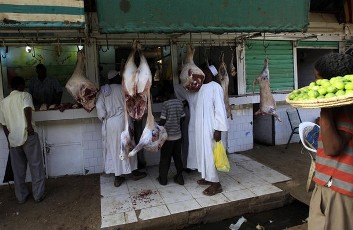Sudanese currency flirting with record low against US dollar
June 21, 2014 (KHARTOUM) – The Sudanese pound (SDG) appeared to be on the verge of hitting a new low milestone against the United States dollar (USD) which is likely to further aggravate the country’s economic woes.
 Currency dealers on the black market said that 1 USD is now trading for 9.6 SDG, up from 9.4 last week. Sudan’s Central Bank indicative exchange rate for the USD stood at approximately 5.7 SDG.
Currency dealers on the black market said that 1 USD is now trading for 9.6 SDG, up from 9.4 last week. Sudan’s Central Bank indicative exchange rate for the USD stood at approximately 5.7 SDG.
According to traders, the USD being in extremely short supply relative to the high demand pushed the SDG further down.
Individuals and businesses alike monitor the informal market’s exchange rate to gauge the state of the economy and make plans accordingly.
Despite government pledges to inject more Forex into the market and crack down on the black market, the SDG continued to drop as banks and Forex bureaus have been unable to meet the demand.
The central bank also does not allow foreign firms in Sudan to repatriate its profits abroad to prevent Forex bleeding.
Sudanese officials have periodically made announcements of Forex infusions from Arab countries to pacify the market. The latest was last April when the government said that Qatar deposited $1 billion in its central bank.
The central bank refuses to disclose the amount of Forex reserves it holds but a report released by the International Monetary Fund (IMF) last year shows it to be holding $1.6 billion in 2013 which covers only two months of imports compared to $1.7 billion in 2012.
Sudan has been struggling to narrow the gap between the official and black market rates of foreign currency exchange which has been widening since the country lost its main source of hard currency revenues due to the secession of the oil-rich south in July 2011.
Because Sudan does not produce enough food to feed its population, it uses a significant portion of its Forex for food imports. As a result, the prices of commodities kept rising with every drop in local currency.
The government quietly devalued its currency last September bringing it down from 4.4 pound to 5.7 for one US dollar.
But last month, the IMF urged Sudan to allow more exchange rate flexibility.
“Against this background, the mission noted, however, the widening gap between the official and parallel market exchange rates. This gap is the result of a range of factors, including uncertainty about the revenues from oil transit as the conflict in South Sudan continues, domestic political uncertainty in the run-up to next year’s presidential elections, and imbalances in the foreign exchange market,” the IMF said in a statement at the conclusion of a visit by its mission to Khartoum during April 29-May 8, 2014 to conduct the first review under Sudan’s 2014 Staff-Monitored Program (SMP).
In a related issue, a Sudanese official denied that the economy is in an economic crisis and instead described it as a “problem”.
The state minister of finance Abdel-Rahman Dirar told economic sector ministers in Gezira state that basic services are available, civil service is stable and ability to fulfill urgent needs remain intact despite rising prices and deteriorating exchange rate.
Dirar also warned that the federal government will no longer fill the states’ budget holes and will only pay each state’s share in the national income.
(ST)
